On July 12, 2023, the Bank of Canada raised its key interest rate by 0.25% to 5%—the highest level since 2001. This decision by the central bank is a response to the enduring excess demand as they strive to bring inflation back within the desired 2% target range. However, the bank now anticipates that achieving this target will be delayed until the middle of 2025.
When interest rates rise, it presents a twofold challenge: both your business and you as an individual can be affected. It’s crucial not to dismiss discussions about a possible recession simply because there are no immediate signs or clear indicators of an upcoming economic downturn. Falling into complacency or skepticism can have serious consequences. It may lead to inadequate preparation and a failure to take necessary precautions, leaving you more vulnerable to economic shocks if a recession does occur.
That’s why we have curated this collection of in-depth insights for you. These valuable resources will equip both you and your business to navigate the challenges and seize the opportunities presented by the evolving economic landscape.
Check out these essential insights for navigating the reality of high-interest rates and potential recessionary impacts.
What the Economic Landscape Means for You and Your Business
In this must-read blog, Nate addresses:
- Why you should identify new profitable sales opportunities for your goods and services
- How to set up an inflation task force
- Why you should adjust your pricing
- Why it’s important to pay attention to uncertainty in demand
- How to understand the financial health of your customers
By Raising Interest Rates, the Bank of Canada Is Aiming to Curb The Inflation We’re Experiencing Now
ASK YOURSELF: “WHAT NEW OPPORTUNITIES DO WE HAVE FOR PROFITABLE SALES RIGHT NOW?”
Recessive markets create contraction but do not get rid of the inherent demand for consumer spending. We are people who need certain things to survive, be entertained, and live a fulfilling life.
Let’s look at some examples:
- After the 2008 U.S. Recession, Wal-Mart made more money in 2009 than they ever did in the history of the company.
- Amazon tripled their revenue during the pandemic – they went from $10B USD to over $30B USD in 12-18 months.
It’s important to consider what lines you can invest in. What customer base can you serve that you never had the opportunity to before (because their demands are changing)? What can you do differently to take advantage of the market chaos?

SET UP AN INFLATION TASK FORCE
An inflation task force is a select group of people from each of the following focus area functions who report to the CEO or CFO. They are the ones in charge of identifying what needs to change about their functional area as it relates to inflation.
- PRICING
- PURCHASING & INVENTORY MANAGEMENT
- ACCOUNT MANAGEMENT
- ACCOUNTS RECEIVABLES
- R&D AND INNOVATION (If you end up getting excess cash, be sure to put it into inflation-proof investments.)
- LABOR COSTS

ADJUST YOUR PRICING TO REFLECT THE MARKET
In a recent study by Simon Kucher—pricing strategy advisor to roughly half of Fortune 500 Companies—executives, on average, predicted they would lose 27% of their sales volume as a result of price increase during non-inflationary times. In the end, the real volume loss was only 4%.
Especially amidst the current economic landscape, your customers are expecting a price jump and may even start to question your business if nothing changes. 87% of business have raised prices more than normal because of inflation.
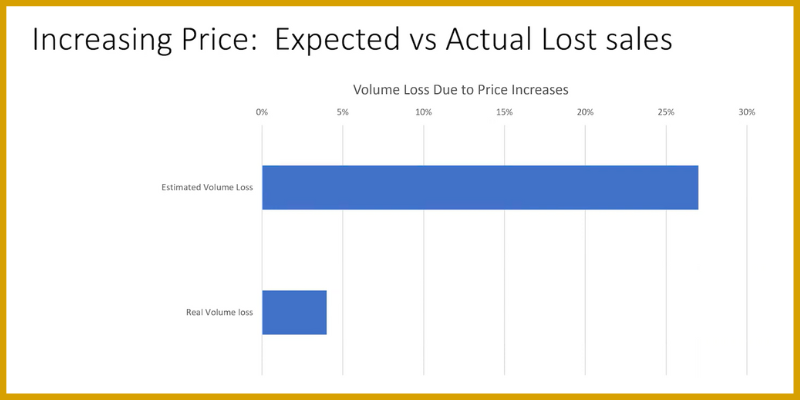
Chart from: Nate Kaemingk
SET YOUR TOP PRICE INCREASE TO BE 2 OR 3 TIMES YOUR AGGREGATE TARGET
Price increases are only 30%-50% effective in aggregate. This means that your overall price increase will be less than your total target because of the response from different categories of customers:
- Customers you have existing contractual pricing agreements with. This can happen when we don’t change our “price-is-good-for” number.
- Customers who understand the need to raise prices, but may negotiate a bit to be able to continually purchase from you.
- Customers who are accepting of the price increase. These customers are usually more focused on quality/convenience over price.

Chart from: Nate Kaemingk

PAY ATTENTION TO UNCERTAINTY IN DEMAND
When doing demand forecast and supply chain planning, it’s important to identify and account for areas with more uncertainty than usual, both long term and short term. Each function of a business will watch and prepare for different peaks and valleys of uncertainty.
For example, operations and inventory planning functions will care more about the potential peaks (upside uncertainty) beyond the expected demand. Rather than just always adding an extra “safety net” of inventory throughout the year, learn to characterize when this upside uncertainty is more likely and refrain from keeping extra stock until then. On the other hand, functions like sales and finance might need to prepare more for the potential valleys (downside uncertainty).
Risk management functions, then, will focus on it all to plan for any and every scenario. When a business campaign or strategy goes well once and poor the next time, that will show up in the data as an uncertainty. This means you didn’t execute as well as you did the first time and you have an opportunity to do better. Find ways to identify uncertainty so you can plan around and mitigate the risk.

Chart from: Nate Kaemingk

UNDERSTAND THE FINANCIAL HEALTH OF YOUR CUSTOMERS
The last thing you want is to execute heaps of pricing work, put together the contract, and then see your customer’s company go under because they didn’t do the same kind of pricing work and preparation that you did.

With the recent increase in interest rates, don’t overlook action in your supply chain. This could involve improving productivity, reducing expenses, optimizing cash flow, minimizing inventory, or adjusting prices to reflect increased costs.
Professor M. Johnny Rungtusanatham offers lessons for business leaders to learn more about their supply chain management and prepare themselves for future disruptions.
Rising Interest Rates Affect Business Supply Chains
We sat down with professor M. Johnny Rungtusanatham to glean expertise around logistics and supply chain management, what is causing supply chain issues, and to get his top five tips to improve your management of supply chains.
Rungtusanatham is Canada Research Chair in Supply Chain Management at the Schulich School of Business, York University; a 2017 Fellow inductee of the Decision Sciences Institute, and an award-winning researcher and educator. He is considered one of the top 50 authors of operations management research and supply chain management research and one of the top contributors to the field of Operations Management, according to published sources.
What is supply chain management, anyway? According to IBM,
“Supply chain management is the handling of the entire production flow of a good or service — starting from the raw components all the way to delivering the final product to the consumer.”
Without further ado, let’s dig into professor M. Rungtusanatham’s expertise and become well equipped to make better decisions and become better leaders.
5 TIPS TO IMPROVE MANAGEMENT OF SUPPLY CHAINS
WITH PROFESSOR M. JOHNNY RUNGTUSANATHAM
TIP 1: USE RIGHT6TM Goal AS YOUR NORTH STAR
Effectively managing a supply chain means aiming for, what I call, the Right6TM goal. This refers to getting your product:
- To the right customer
- In the right quantity
- With the right quality
- At the right time
- In the right location
- At the right price
If, at any time, one of these six criteria is not satisfied, it is an indication that you are not effectively managing your supply chain.
It’s helpful to think of the supply process as interactions between many networks rather than a linear chain, and disruption within the network is a matter of when, not if. It’s inevitable. The goal, then, is to minimize disruptions and the time it takes to recover from a disruption.
Check your decisions against this goal to avoid surprises. Keep in mind that there won’t be a perfect decision that will satisfy all six rights. For example, if you decide to source from someone with a higher quality, you may be paying a higher price.
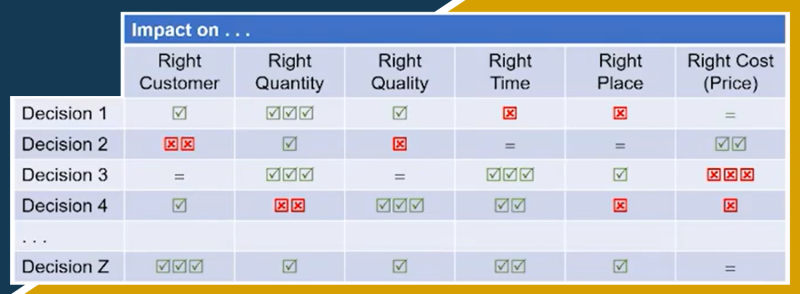
TIP 2: MAGNIFY VISIBILITY INTO YOUR SUPPLY CHAIN
According to Deloitte, 65% of 500+ procurement leaders from 39 countries only have visibility of their tier 1 suppliers. Meaning, they don’t know who their suppliers really are.
That being said, supply chains today are very complex, long, and have limited visibility. They involve global sourcing activities with multiple hand-offs and transfers.
Figure out how your goods flow—starting from as far up the supply chain as possible all the way down until it reaches you.
Because, let’s be honest, you cannot manage well what you do not see.

To start magnifying your visibility, ask yourself these questions:
- Where do my goods enter or exit Canada?
- How much of my goods are going through one point?
- What are my backup options?
- Who really manufactures my goods? Who are THEIR suppliers?
- How far up supply chains do I interact?
- Where are the hand offs in the supply chains? The more hand offs, the more opportunities for damage, loss, etc.
- Who is responsible for hand off integrity? Me? A third party?
TIP 3: PRIORITIZE YOUR PURCHASES TO PRIORITIZE ASSOCIATED ACTIONS
Classify your purchases, what you source, into the four buckets in the Kraljic Matrix. You don’t have time to focus on or control everything, but you must make time to prioritize the most important. Strategic goods, for example, are of high importance because there is a high risk of supply not being available and they have tremendous impact on whether or not you make money.
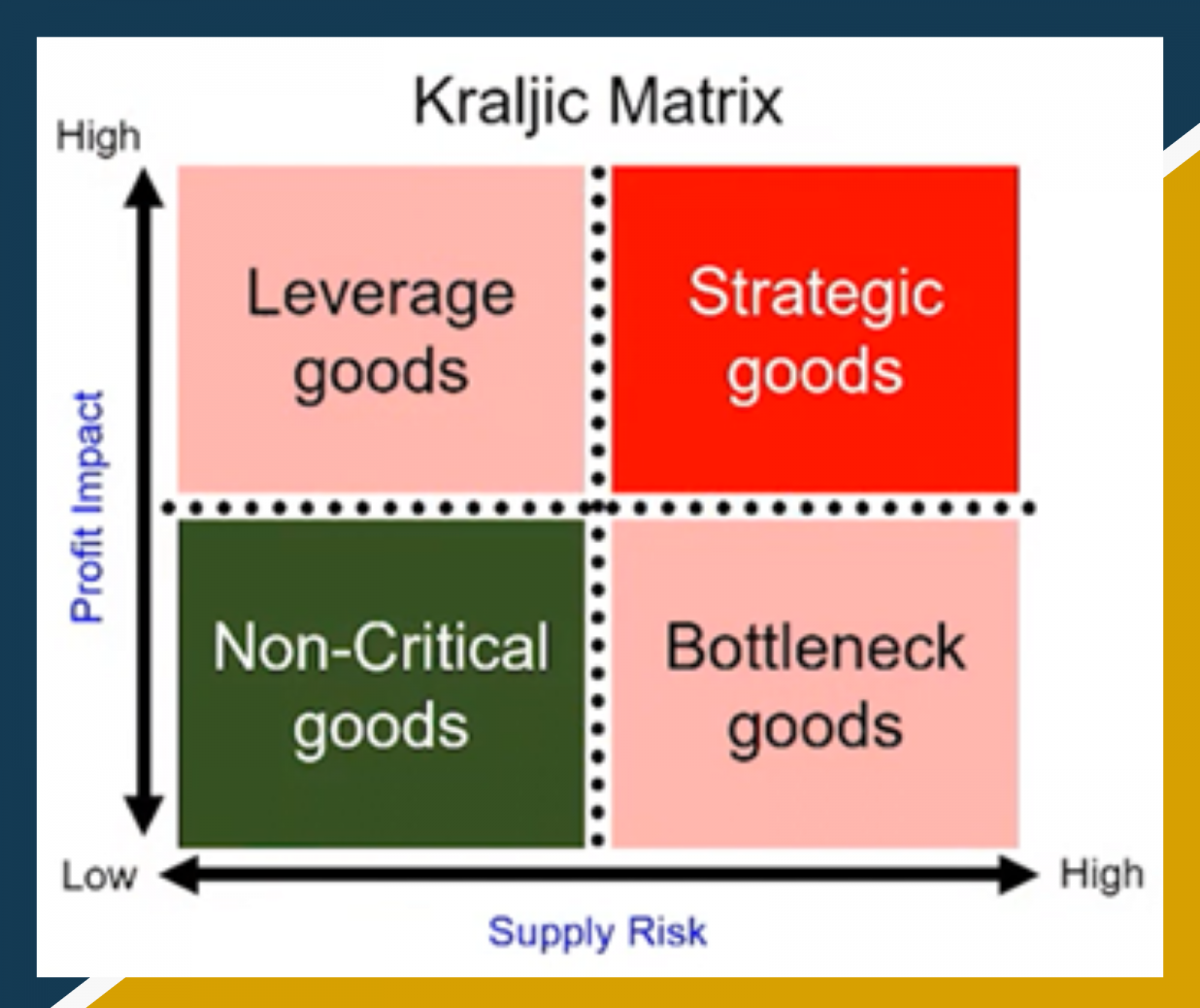
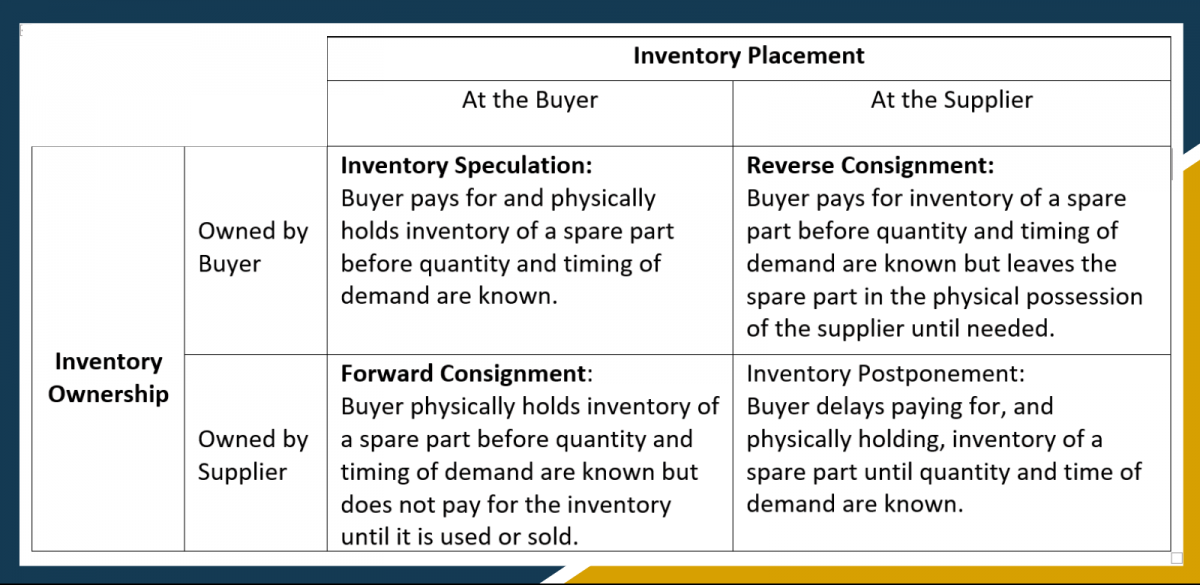
Depending on how you classify your goods and purchases, you can determine their inventory placement using the chart above. For strategic goods, for example, you would never consider Inventory Postponement.
Here are some rules of thumb to best manage your different categories of inventory (remember: for any type of consignment, ensure you have a contractual agreement and a high degree of trust with your supplier):
- If you have no financial or physical storage constraints, use inventory speculation. You know you will eventually use these goods.
- If you have financial constraints, but no physical storage constraints, use forward consignment. Ask your supplier to let you hold inventory and pay them once you use the supply.
- If you have physical storage constraints but no financial constraints, use reverse consignment. Your supplier holds on to the inventory on your behalf, but you own it.
- If you have physical storage and financial constraints, use inventory postponement. This is a good option for non-critical goods (easily available and have little impact on whether or not you make money)—you don’t have to stockpile, just place an order when you know when and what you need.
TIP 4: DIVERSIFY TO REDUCE SUPPLY MANAGEMENT RISK
While supply chains today produce complex products, they also involve fewer suppliers due to supply base rationalization. The number of critical nodes in your supply chain is reduced, which also reduces your power over your suppliers and increases your vulnerability to disruption because there are fewer nodes.
Because of this, you don’t want to put all your eggs in one basket (or buy all your supplies from one country!).
Instead, establish near-far options with proper risk-based allocation. Leverage most of your supply with volume-based pricing from a supplier far away, and a smaller portion from a nearer supplier. This way, if there is a disruption (from afar), you can continue to work. While it might be at a slower rate, you won’t be forced to shut down.
If you must single source from far away, ensure you have someone there who works for you to keep an eye out.

TIP 5: INVEST IN “ADDAPT” CAPABILITIES
- ANTICIPATE – Your ability to systematically remember known triggers, foresee unknown-but-knowable triggers, and imagine why and how they could cause supply disruptions. Think about investing in a person or team who can give you this information and read the news to find out what is happening near and far that could impact you.
- DIAGNOSE – You cannot solve a problem unless you know exactly what is going on. This refers to your ability to wholistically understand a supply disruption in terms of:
- The risks that would cause flows of goods to be interrupted
- The nature of the interruption
- The options available to restore the flow of goods to the expected level as quickly as possible
- DETECT – Your ability to recognize and be warned at (ideally) the exact instance when a supply disruption trigger interrupts the physical flow of goods.
- TRACK – Your ability to monitor the right information, update it, and elevate it to the right decision makers to ensure you supply chains are humming along.
- PROTECT – Your ability to prevent supply disruptions triggered by known and unknown-but-knowable risks. How are you redesigning the supply chain to ensure it’s not vulnerable to the same event that occurred in the past?
For more information about these capabilities and what leaders can do to develop and nurture them, click here.
Assess Your Current Employee Capacity and Maximize Performance
To safeguard your balance sheet in the face of elevated interest rates, retaining current employees is crucial.
When employees depart, the organization not only loses valuable knowledge but also incurs recruitment costs, and vacation payouts, and experiences a dip in productivity due to an under-resourced team. In a competitive job market where employees hold the upper hand, the risk of losing talent becomes even more significant.
For invaluable insights on navigating these challenges, turn to Eddie LeMoine’s expertise below.
WHAT IS EMPLOYEE ENGAGEMENT?
Employee engagement happens around inclusion and co-creation. It means everyone gets involved—employees, the leadership team, the community you work in, clients, suppliers, and everyone in between.
When it comes to employee engagement, we look for something magical called discretionary effort. This means that the work the employee does at their job is in alignment with the organization’s goals and the organization is leveraging the individual strengths of those employees to reach those goals.
When all employees are emotionally committed to the success of their employer, magic happens. Profitability happens. Cost containment happens. Safety happens.
BENEFITS OF EMPLOYEE ENGAGEMENT
Engagement, enabling, and empowering the team you already have is the easiest way to add capacity and profitability to your organization. You don’t need to buy new software or find a new office space, you simply need an action plan to fire up the team that already shows up to work every day.
For employees, it gives them a sense of purpose—they are happier, see an opportunity for personal growth, and align their strengths with organizational goals. Only 15% of engaged employees would consider leaving their job, while 85% of unengaged employees would consider leaving theirs.
For employers, it makes it easier to attract and retain top talent and increases both sales and productivity. Engaged employees will recommend their place of work to others, which makes attracting talent more natural.
For customers, it increases satisfaction and referrals.
According to a Towers Watson survey for Fortune 500 companies: Organizations with low engagement have a 9% operating margin, organizations with highly engaged employees can have a 14% operating margin, and those with engaged, enabled, and empowered employees can have a 27% operating margin. What’s more? They can have 50% higher sales, 50% higher customer loyalty, and 38% above-average productivity. Source: Gallup
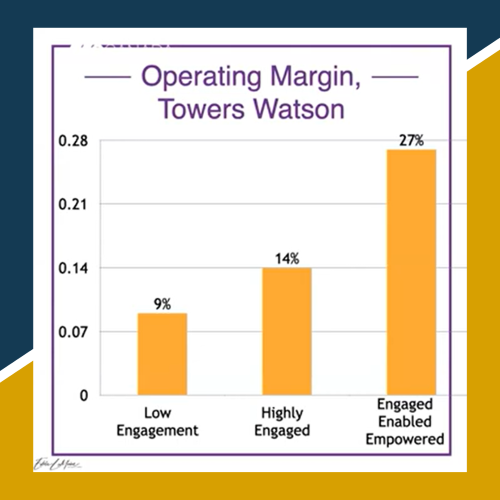
WHY IS EMPLOYEE ENGAGEMENT IMPORTANT RIGHT NOW?
POST-PANDEMIC RECRUITMENT
New to the world in such great numbers are businesses hiring for entirely remote work—people can hire from anywhere and work from anywhere. This means that it will be harder for smaller, more local companies to compete with wages and signing bonuses from larger employers.
If you’re struggling to find new employees, “turning on” your current employee base is the easiest way to increase capacity in your organization.
GENERATIONAL DIFFERENCES
Baby Boomers typically only change careers three times before retirement. Millennials, on the other hand, have an employment expectation of less than 18 months.
So, what does this mean? Retaining employees is only getting more difficult, so we need to get more productivity out of people and faster.
3 QUESTIONS EVERY EMPLOYEE ASKS
There are three questions every employee asks. As a leader, these questions are more important to you than ever. The answers speak to your company culture, work environment, and can contribute to improved employee engagement.

1. “WHY IS THIS JOB IMPORTANT TO ME?”
This is why employees join an organization.
- Geography
- Compensation
- Benefits
- Vacation
- Location
Employee recruitment tip: Bring new employees in at the right level of compensation immediately. You don’t want to have to revisit their pay scale right away.
2. “WHO WILL I BE WORKING WITH?”
This is why employees stay with an organization.
- What is my boss like?
- What are my fellow employees like?
- Can I interact with internal resources?
- Who are my clients?
- Is it bureaucratic?
3. “WHAT EXACTLY WILL I BE DOING?”
This is why employees leave an organization.
Today’s employees feel a need to be truly passionate about what they do. Oftentimes, employees are slowly tasked with additional things that they were not hired to do. Not enjoying their work is the #1 reason why employees leave organizations.
6 KEY ATTRIBUTES OF SUCCESSFUL LEADERSHIP
Wondering how to increase employee engagement? Successful leadership is critical to leading an engaged workforce. If you can embody these 6 attributes, your retention of talent will be more resilient.
1. Empathy
Put yourself in the shoes of your clients, employees and partners. For example, not everyone might be comfortable coming back in the office full time post pandemic – be empathetic to this.
2. Flexibility
Because the pandemic has changed the way we do business in all facets, leaders need to show a willingness to do things differently
3. Truthfulness and Trust
Be open about what you know and what you don’t know—the younger your workforce, the more important this is.
4. Clarity
Be clear about the plans of your organization and the role people play in achieving organizational objectives. This way, employees know how to align their strengths with the direction.
5. Communication
This has always been crucial to improved employee engagement, but with more and more emerging hybrid environments, it’s more critical now than ever.
6. Empowerment
With employee turnover averaging every 24 months, it’s imperative to empower employees quickly so they can provide as much value as possible within their short stay. Empowerment is also to assist your employees in making rapid decision during a crisis.

THREE STAGES TO CLOSING THE ENGAGEMENT GAP
1. KNOW YOUR EMPLOYEES
It’s important to work and communicate across the different spectrums present among your employees:
- Gender perspective – acknowledge the range of values, beliefs, and communication styles across genders.
- Cultural perspective – every single net new job in Canada is going to be filled by someone who currently doesn’t live here.
- Generational perspective – there are five generations in the workforce right now, so it’s imperative to know how to communicate with each.
2. DEVELOP YOUR EMPLOYEES
Identify the individual strengths of each employee and align it with your organizational goals. Personal and professional development will help you build capacity AND engagement while reaching increased levels of employee satisfaction.
3. MOTIVATE YOUR EMPLOYEES
Be inspiring. Leaders who can inspire their team will get the lion’s share of good employees.
Are You Equipped With the Power of a Peer Group?
If you’re a CEO, business leader, or owner, you know that the challenges you face on a daily basis are only getting more complex. From navigating changing market conditions to managing an increasingly diverse workforce, it can be tough to stay on top of everything. But how do you expand your thinking to achieve growth? It’s easy to get stuck in the same old ways of doing things, and in today’s rapidly changing business landscape, that’s simply not enough.
Tim Redpath, TEC Canada Chair, shares why.
The Power of Peer Groups: Leveraging The Collective Strength
Over the years, Tim Redpath has witnessed the powerful impact of his TEC confidential peer executive groups on personal and professional growth. He has seen countless examples of business leaders achieving remarkable success through the help of their peer group’s invaluable and diverse range of perspectives. In fact, he believes the benefit of joining a peer group to be far-reaching and long-lasting.
Overcoming Financial Challenges
Running a business is not always smooth sailing. Companies face various challenges that can push them to the brink of bankruptcy. For a member of Tim’s group, this was the reality they were facing, it was clear their company was struggling financially. Through open discussions with their fellow group members and an in-depth analysis of their company’s financial situation, they were able to identify the root cause of the problem and develop a plan to turn the company’s situation around and bring it back from the brink of bankruptcy to achieve double and triple-digit growth, year after year. The support and guidance the peer group provided enabled the member to create a more robust and agile business that could adapt to changes in the industry and continue to thrive.
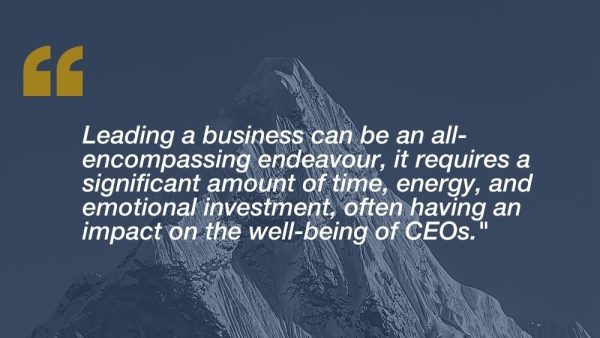
Leading a business can be an all-encompassing endeveour, it requires a significant amount of time, energy, and emotional investment, often having an impact on the well-being of CEOs. Considering this, peer group support can be crucial not only in identifying and addressing financial challenges, but also in providing a much-needed source of emotional support for leaders navigating the demands of their roles.
Emotional Support for Leaders
As the CEO of a growing company, the pressure to perform can be overwhelming. The relentless demands of the job can often lead to long hours, non-existent work-life balance, and the need to always stay on top of everything. Unfortunately, this pressure can take a severe toll on even the most capable leaders. This is what Tim witnessed in one of his group members who was struggling with depression, unable to cope with the stress of the job. During a TEC group meeting, Tim noticed something was off with the member and reached out to them privately. It was then that they admitted to struggling with depression. Thankfully, Tim and the TEC group were incredibly supportive and understanding, by listening to their concerns they provided the resources they needed to cope. One of the biggest challenges that the member faced was difficulty in delegating tasks to their staff. As a leader used to being in control, it was hard for them to trust others to undertake tasks the way they wanted it done. This mentality only added to their stress levels, leading to their depression as they found themselves micromanaging every aspect of the business. However, through their TEC group’s encouragement, moral support, and seasoned guidance, the member learned that effective delegation was key to not only reducing their workload but also empowering their team and holding staff accountable. Ultimately, this allowed the CEO to overcome their depression and become a stronger more effective leader in the long run.
The story of Tim’s group member struggling with depression highlights how the demands of the job can have a devastating impact on a person’s mental health. However, as we navigate through personal hardships, it’s essential to recognize that we’re not alone in our struggles, and there is support and guidance available, even at the CEO level. TEC’s leadership peer groups can make all the difference in overcoming personal challenges.
Conquering Personal Hardships
When we face personal hardships, it’s easy to feel isolated and alone. We may feel like we’re the only ones going through a particular situation and that no one else could possibly understand how we feel. However, this is far from the truth. Many leaders have experienced similar challenges, and they can offer valuable emotional support and guidance. When a member of Tim’s group was going through personal hardship, they found compassion and care from their peers in their group. The emotional support they received had a significant impact on their mental health and well-being. They felt less alone, validated, and heard, which helped to reduce their stress and anxiety levels. Additionally, the practical advice and resources they received helped them to cope with their grief more effectively. Furthermore, the sense of community and belonging that came from being part of a confidential peer group helped them to build resilience and cope with this and future challenges more effectively.
Harnessing Collective Wisdom
Tim Redpath’s experiences demonstrate that by working together and sharing knowledge and guidance, remarkable success can be achieved. Through the group’s rich and diverse perspectives and insights, each member can benefit from the collective wisdom, building a stronger team relationship and a united front.
Joining a peer group can offer a multitude of benefits and equip you with the tools needed to overcome challenges and accomplish your goals, without having to face it alone, and that’s where TEC Canada comes in.
At TEC, your peer members can help you to step out of your comfort zone and start thinking bigger to help you unlock your full potential and achieve the success you’ve always dreamed of. Through the power of your peer group, you’ll be able to fearlessly approach the issues facing your business, knowing you have the full support and guidance you need to make better decisions.
But TEC isn’t just about making decisions – it’s about being held accountable for seeing those decisions through to completion. With a vested group of leaders from non-competing industries, you can expect to be pushed to reach beyond what you thought was possible, both as a person and as a leader.
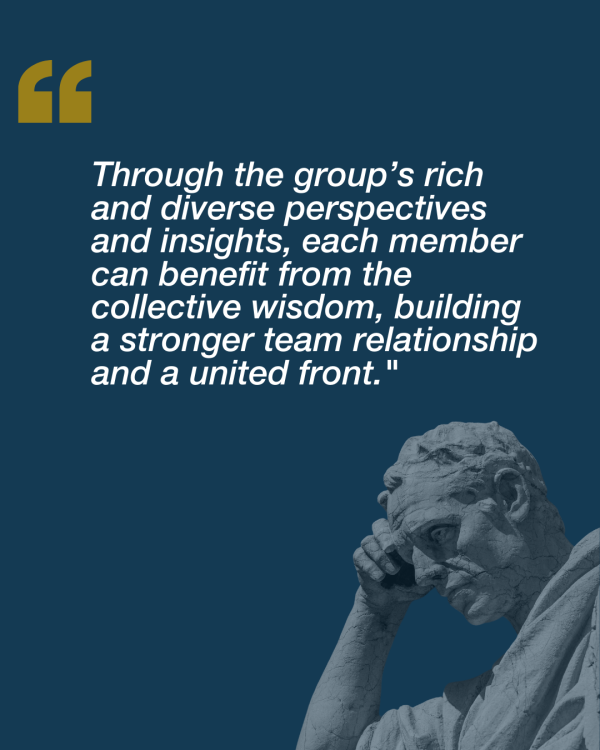
Support and Community: TEC’s Role for CEOs, Leaders, and Owners
And perhaps most importantly, TEC provides a source of support and community that is all too often lacking for CEOs, leaders, and owners. As a business leader, it can be lonely at the top and making decisions can be daunting, especially when you’re the one responsible for the success or failure of your company. Free from isolation, you’ll be able to connect with other like-minded professionals and gain the intuition and outlook you need to cope with the constant changes in the economy, your business, and your professional life.
If you’re seeking a supportive network of peers who challenge, encourage, and guide you toward achieving your goals, a TEC group is just the beginning. So don’t hesitate, take the first step towards growth and success – join a TEC group today. Learn more.










